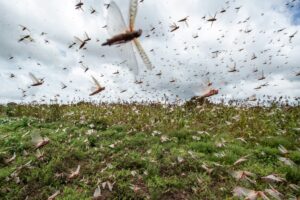 Locust outbreaks are already a nightmare for millions of people, destroying crops and threatening food supplies. Now, scientists warn that these outbreaks are likely to get worse as the climate changes but they also believe that working with local communities could be key to stopping the damage.
Locust outbreaks are already a nightmare for millions of people, destroying crops and threatening food supplies. Now, scientists warn that these outbreaks are likely to get worse as the climate changes but they also believe that working with local communities could be key to stopping the damage.
A new research paper explains that locusts, which are a type of short-horned grasshopper, can suddenly switch from living quietly on their own to forming huge, fast-moving swarms. These swarms can travel hundreds of kilometers, eating nearly every green plant they find. One species, the desert locust (Schistocerca gregaria), is described by scientists as one of the most destructive pests on the planet. A single swarm made up of tens of millions of these insects can cover more than 1,200 square kilometers an area bigger than many cities and destroy crops that feed thousands of people.
In 2020, eastern Africa suffered one of the worst locust invasions in decades, putting the food security of over 20 million people at risk.
Why Climate Change is Making It Worse
The researchers say climate change is creating perfect conditions for more frequent and severe locust outbreaks. Extreme rain, tropical cyclones, and unusually warm, moist soil all linked to global warming can trigger massive locust breeding. Yet, despite the clear link between climate change and locust problems, the issue remains under-discussed in climate action plans, they warn.
One major problem in fighting locust swarms is detecting them early enough. In remote and hard-to-reach areas like parts of eastern Africa, it is difficult for scientists and officials to check on breeding sites or spot early swarm formations especially when these areas are unsafe due to conflict or rough terrain.
Although the U.N. Food and Agriculture Organization (FAO) runs a 24/7 satellite-based system to watch for locust threats, it relies on people in the field to verify what the satellites are seeing. This is not always possible because the locust breeding grounds are far from cities and towns.
Why Local Communities Matter
This is where local communities could make a big difference. The study highlights how Indigenous peoples and farmers have valuable traditional knowledge passed down over generations. These people know the land, weather patterns, and even the signs that locusts are about to swarm. In the 2020–21 outbreak, for example, alerts from villagers in remote areas helped warn governments before the swarms spread too far.
The researchers suggest that training these local communities to use technology — like mobile messaging apps and digital platforms such as EarthRanger and eLocust — could make early detection much easier and faster. Even in areas without mobile networks, these tools can record and send important locust data to officials in real time. With the help of artificial intelligence, this data could also be combined with satellite images and weather forecasts to predict where locusts might breed or swarm next.
A Greener Way to Fight Locusts
But catching locusts early is only part of the solution. Once the swarms form, many governments turn to chemical pesticides, spraying them over large areas from airplanes. While this can kill locusts quickly, it also harms the environment, other insects, and sometimes human health.
The researchers urge a switch to eco-friendly biopesticides and safer methods that target locusts without damaging the wider ecosystem. These options, they say, are better for people, wildlife, and the land in the long run.
